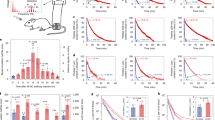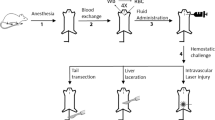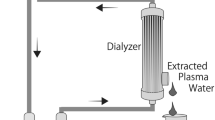Abstract
Experiments were undertaken to test a new hypothesis for the mechanism underlying the Révész effect. The hypothesis proposes that lethally irradiated (LI) tumour cells enhance the take probability of a small number of transplanted viable (V) tumour cells mixed with them by exerting a thromboplastic effect at the site of injection; local fibrin formation prevents emigration of V cells from the site or secures their survival there. The evidence presented to support this hypothesis is as follows: in the case of 3 isogeneically transplanted tumours, admixed particulate brain extract simulated the effect of LI cells in increasing the take probability of V cells; brain extract simulated the effect of LI cells in greatly delaying the disappearance of 125IUdR-labelled viable carcinoma cells from the injection site; V cells acquired a raised take probability by their incorporation in fibrin clots; it was confirmed that admixed erythrocytes increased the take probability of V cells; using a newly devised microscopical test for detection of the thromboplastic activity of individual cells, it was found that cell death was almost always required for the display of such activity; lymphocytes and bone marrow cells, ineffective in enhancing the take of V cells, were almost totally devoid of thromboplastic activity. Possible explanations are given for failure of a fibrinogen depleting agent, ancrod (Arvin) to inhibit the Révész effect when administered to recipients. It is concluded that the evidence strongly supports the hypothesis presented whilst seriously weakening the long-standing theories that admixed LI cells act by provision of nutrients or by local quenching of postulated immune reactivity.
This is a preview of subscription content, access via your institution
Access options
Subscribe to this journal
Receive 24 print issues and online access
$259.00 per year
only $10.79 per issue
Buy this article
- Purchase on Springer Link
- Instant access to full article PDF
Prices may be subject to local taxes which are calculated during checkout
Similar content being viewed by others
Rights and permissions
About this article
Cite this article
Peters, L., Hewitt, H. The Influence of Fibrin Formation on the Transplantability of Murine Tumour Cells: Implications for the Mechanism of the Révész Effect. Br J Cancer 29, 279–291 (1974). https://doi.org/10.1038/bjc.1974.68
Issue Date:
DOI: https://doi.org/10.1038/bjc.1974.68
This article is cited by
-
Influence of implantation site on formation of metastases
CANCER AND METASTASIS REVIEW (1983)
-
Invasion of malignant C3H mouse fibroblasts from aggregates transplanted into the auricles of syngenic mice
Virchows Archiv B Cell Pathology (1979)



